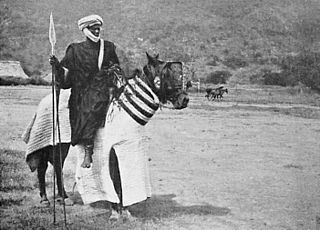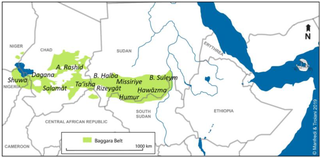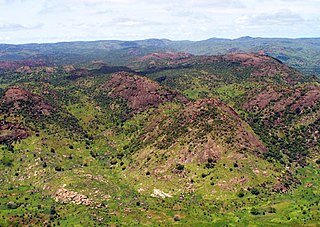
The zebu, sometimes known in the plural as indicine cattle or humped cattle, is a species or subspecies of domestic cattle originating in the Indian sub-continent. Zebu are characterised by a fatty hump on their shoulders, a large dewlap, and sometimes drooping ears. They are well adapted to withstanding high temperatures, and are farmed throughout the tropical countries, both as pure zebu and as hybrids with taurine cattle, the other main type of domestic cattle. Zebu are used as draught and riding animals, dairy cattle, and beef cattle, as well as for byproducts such as hides and dung for fuel and manure. Some small breeds such as the miniature zebu are also kept as pets. In 1999, researchers at Texas A&M University successfully cloned a zebu.

The Baggāra or Chadian Arabs are a nomadic confederation of people of mixed Arab and Arabized indigenous African ancestry, inhabiting a portion of the Sahel mainly between Lake Chad and the Nile river near south Kordofan, numbering over six million. They are known as Baggara and Abbala in Sudan, and as Shuwa Arabs in Cameroon, Nigeria and Western Chad. The term Shuwa is said to be of Kanuri origin.
The Fur are an ethnic group predominantly inhabiting western Sudan. They are concentrated in the Darfur region, where they are the largest ethnic group. They speak the Fur language, which belongs to the Nilo-Saharan family.

Western Bahr el Ghazal is a state in South Sudan. It has an area of 93,900 km2 (36,255 sq mi) and is the least populous state in South Sudan, according to the controversial Sudanese census conducted in 2008. It is part of the Bahr el Ghazal region. Its capital is Wau. The state shared international borders with Sudan to the north and the Central African Republic to the west. The portion now occupied by Raga County is the southern part of the historical region known as "Dar Fertit".

The Nuer people are a Nilotic ethnic group concentrated in the Greater Upper Nile region of South Sudan. They also live in the Ethiopian region of Gambella. The Nuer speak the Nuer language, which belongs to the Nilotic language family. They are the second largest ethnic group in South Sudan. The Nuer people are pastoralists who herd cattle for a living. Their cattle serve as companions and define their lifestyle. The Nuer call themselves "Naath".

Hawazma, part of Sudan's Baggara tribe, are cattle herders who roam the area from the southern parts of North Kurdufan to the southern borders of South Kurdufan, a distance of about 300 kilometers. Through their nomadic movement, the Hawazma know the area, terrain, ethnic groups, local tribes, tribal cultures, ecosystems, climate, vegetation, existence of risks and diseases, and water resources better than any other inhabitants of the region. The term Baggara is a collective name applied to all cattle-herding tribes with Arab roots. Cattle herders from Nuba tribes are not called Baggara. Cattle herders of middle and eastern Sudan, although they Arabic in roots, are also not Baggara. The Baggara occupies a wide area, from Kordofan, Mid-Western Sudan, to Darfur in the far Western Sudan and extending to neighboring Chad. They are a collection of seven major tribes: Hawazma, Messiria Humr Messiria Zurug, Rizeigat, Ta’isha, Habbaniya, Beni Halba, Awlad Himayd, and Beni Selam. All Baggara have close physical characteristics, costumes, dance, religion, food, and in general a common culture and way of life.

Dairy cattle are cattle bred for the ability to produce large quantities of milk, from which dairy products are made. Dairy cattle generally are of the species Bos taurus.

The Nuba Mountains, also referred to as the Nuba Hills, is an area located in South Kordofan, Sudan. The area is home to a group of indigenous ethnic groups known collectively as the Nuba peoples. In the Middle Ages, the Nuba mountains had been part of the Nubian kingdom of Alodia. In the 18th century, they became home to the kingdom of Taqali that controlled the hills of the mountains until their defeat by Mahdi Muhammad Ahmad. After the British defeated the Mahdi army, Taqali was restored as a client state. Infiltration of the Messiria tribe of Baggara Arabs has been influential in modern conflicts. Up to 1.5 million people live in the mountains mostly ethnic Nuba and small minority of Baggara.

Slavery in Sudan began in ancient times, and recently had a resurgence during the Second Sudanese Civil War (1983–2005). During the Trans-Saharan slave trade, many Nilotic peoples from the lower Nile Valley were purchased as slaves and brought to work elsewhere in North Africa and the Orient by Nubians, Egyptians, Berbers and Arabs.

Ta'isha, or Ta'aisha, or Taaisha, one of a series of Arabic-speaking groups collectively called Baggara "cattle people", who live in Sudan, across southern Kordofan, Darfur, as well as Chad. The Ta'aisha tribal homeland is in the far southwest of Darfur, neighbouring to the east the Habbaniya, with whom they are closely related. The Ta'aisha rose to power when one of the members of their tribe, Abdallahi ibn Muhammad, later known as the Khalifa, became an early follower of Muhammad Ahmad, who would later become the Sudanese Mahdi. During the revolution, 'Abdallahi became the strongman of the movement and was designated as senior Khalifa by the Mahdi. Following the Mahdi's death in June 1885, the Khalifa 'Abdallahi ruled the Mahdist state until its destruction by an Anglo-Egyptian army. The Khalifa during his rule brought his tribe to Central Sudan and he went on to make extensive use of his relatives and other fellow Ta'a'isha as soldiers and administrators. Throughout the Mahdist period there was constant tension between the Ta'aisha leaders and the riverain Sudanese. Several Ta'aisha amirs who survived the Mahdiyya became prominent at the re-established Darfur Sultanate of Ali Dinar, one being Arabi Dafallah, who was appointed commander of the Equatorial province with its headquarters at Rejaf under the Khalifa's rule. Having been forced in 1897 to evacuate Equatoria by Belgians advancing from the Congo, he had made his way into southern Darfur where he faced Anglo-Egyptian forces and friendly tribes sent by Kitchener in pursuit of him. He then settled in the area of the present Central African Republic-Darfur border where he came into contact with encroaching French colonial power. After an unsuccessful attack on French outposts in the region he surrendered to Sultan 'Ali Dinar with his men and their arms in 1902, he subsequently lived in Al-Fashir and took part in many of the Sultan's military expeditions. Another one was 'Ali al-Sanusi, who was a Mahdist amir under Mahmud Ahmad in Atbara and fought at Karari after which he escaped to Darfur to be one of 'Ali Dinar's best generals. Under the British colonial rule, He was appointed Nazir of the Ta'aisha in Darfur and rendered valuable service to the new administration.

The Rizeigat, or Rizigat, or Rezeigat are a Muslim and Arab tribe of the nomadic Bedouin Baggara people in Sudan's Darfur region. The Rizeigat belong to the greater Baggara Arabs fraternity of Darfur and Kordofan and speak Chadic Arabic. They are primarily nomadic herders and their journeys are dependent upon the seasons of the year. They are a branch of the Juhayna group. They are divided into the Abbala (camel-herding) Rizeigat, who live in northern Darfur and Chad, and the Baggara who inhabit south-east Darfur. In turn they are divided into several large clans, notably the Mahamid, Mahariya and Nawaiba. The ecological differences between the north and south of Sudan allowed for two different types of nomadism to evolve: camel herders in the north and cattle herders in the south.

The Moro Nuba are a sub-ethnic group of the Nuba peoples in the Nuba Mountains of South Kordofan state, in southern Sudan. Many members of this ethnicity are Christians. The population of this ethnicity possibly does not exceed 100,000.

The Messiria, known also under the name of Misseriya Arabs, are a branch of the Baggara ethnic grouping of Arab tribes. Their language is the Sudanese Arabic. Numbering over one million, the Baggara are the second largest ethnic group in Western Sudan, extending into Eastern Chad. They are primarily nomadic cattle herders and their journeys are dependent upon the seasons of the year. The use of the term Baggara carries negative connotations as slave raiders, so they prefer to be called instead Messiria.
Butana and Kenana breeds are part of the shorthorned Zebu group of breeds of eastern Africa. What makes them unusual is that they are dairy breeds, unlike other breeds like the Boran, Baggara, Fung, etc. The Butana breed is found to the east of Khartoum in central Sudan, in the Butana region. The Atbarah Research Station of the Sudanese Department of Agriculture in Atbarah has a special mission for preserving and improving the Butana breed. The Kenana breed is found just south of Butana, mainly in the region between the Blue Nile and the White Nile.

The Beni Halba is an Arab group located in the western Sudanese region of Darfur. The Beni Halba is one of the major Darfuri Baggara groups, along with the Habbaniya, Rizeigat and Ta’isha, and was granted a large hakura in southern Darfur by the sultans of independent Dar Fur. During the 1980s, recurring drought in Chad prompted several clans of Beni Halba to migrate eastwards and join their kinspeople between Geneina and Kebkabiya and Kutum. In the late 1980s, the ideology then sweeping through the region combining Arab supremacy and Islamic extremism was taken up by many Beni Halba. Under Nazir al-Hadi Issa Debaker, the Beni Halba were actively involved in attacks upon the Fur people starting in 1987 through 1989. In this period a new militia called the Janjaweed, partially drawing upon the Beni Halba, was first formed. In 1991 the Sudan People's Liberation Army, then fighting the Second Sudanese Civil War in the south of the country, sent a force under Daud Bolad to expand the conflict into Darfur. However, Bolad's force was annihilated by a combination of the army and Beni Halba fursan ("horsemen"), who then carried out reprisal attacks against Fur civilians. As a result, the Beni Halba district town of Idd al Ghanam was renamed Idd al Fursan.

Sudanese Arabs are the inhabitants of Sudan who identify as Arabs and speak Arabic as their mother tongue. Part of them are descendants of Arabs who migrated to Sudan from the Arabian Peninsula, although the rest have been described as Arabized indigenous peoples of Sudan of mostly Nubian, Nilo-Saharan, and Cushitic ancestry who are culturally and linguistically Arab, with varying cases of admixture from Peninsular Arabs. The vast majority of Arab tribes in Sudan migrated there in the 12th century and intermarried with the Nubians and other indigenous populations, as well as introducing Islam. The Sudanese Arabs were described as a "hybrid of Arab and indigenous blood", and the Arabic they spoke was reported as "a pure but archaic Arabic". Burckhardt noted that the Ja'alin of the Eastern Desert are exactly like the Bedouin of Eastern Arabia.

South Sudan is home to around 60 indigenous ethnic groups and 80 linguistic partitions among a 2021 population of around 11 million. Historically, most ethnic groups were lacking in formal Western political institutions, with land held by the community and elders acting as problem solvers and adjudicators. Today, most ethnic groups still embrace a cattle culture in which livestock is the main measure of wealth and used for bride wealth.
Mayom County is an administrative region in Unity of South Sudan to the west of Bentiu. The county headquarters is Mayom town.
Rubkona County is an administrative division of Unity State, South Sudan.











